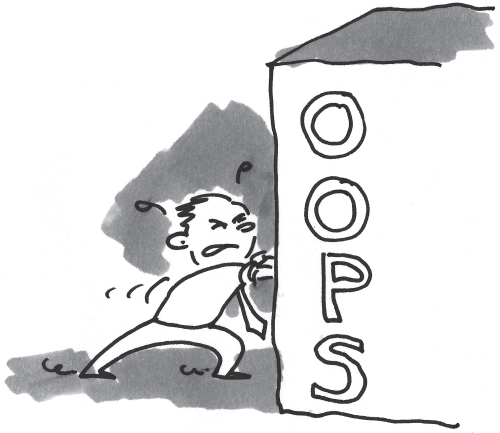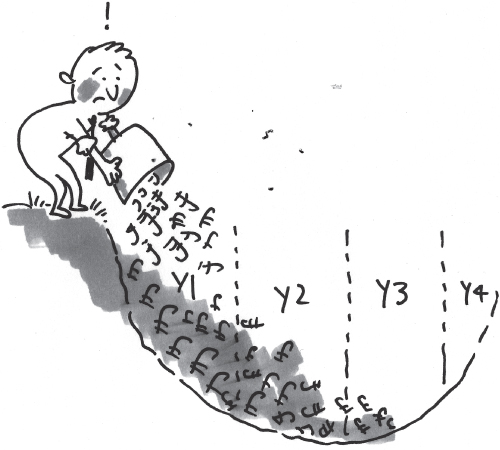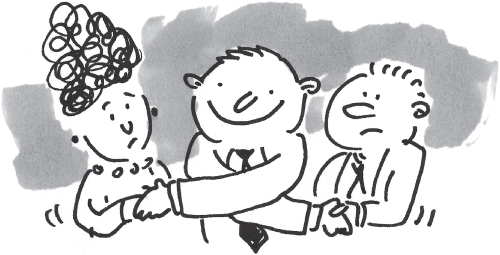CHAPTER 9
BUILDING A GLOBAL SMALL BUSINESS IN THE ENTREPRENEUR REVOLUTION
When you have sufficiently tested your Concept, Audience, Offer and Sales approach, it's time to look at building a business. A business isn't about desks, computers, business cards, staff, accounting software or websites.
You are in business to develop and commercialise assets. That's it.
How that happens takes many forms but, at the core of it, you're creating or sourcing assets like products, intellectual property, systems, brands and people, and then making money from them.
In the CAOS challenge the objective was to test the commercial response to a product or service by simply conducting sales meetings armed with little more than a brochure and a sign-up form. After discovering that you have an idea people are willing to pay for, the real work begins – building out a product ecosystem and a small team. To do that, you'll need to examine your business model and the mix of products and services that will drive revenue and profit.
The ideas in this section are powerful. I've used these ideas to create five start-ups; each went from nothing to a million in sales in under a year. It's these ideas that gave me a company worth millions by age 30.
I've also used these ideas with my clients and seen radical and dramatic increases in revenue and profit.
Provided you have value, we can use the following process to maximise the amount of money you can make from it.
PRODUCT STRATEGY: THE KEY TO MAKING MONEY FROM YOUR IDEA
At the heart of every business is a product. If you have a product, you can begin to build a business. It's very important that you deeply understand the value your product offers, the problem it solves and the reasons customers buy.
I have a strange definition of product.
I define a product as a consistent way of achieving a desired outcome that your customer wants. This definition should get you to see products as things that fulfil desires rather than as commodities.
When I look at a Rolex, I don't see the product as being a watch. I see the product as being ‘a conspicuous device that communicates status and high achievement’.
A person who buys a Rolex doesn't want to buy a device that tells the time. They could buy a cheap Casio that does a better job of telling the time. The desired outcome the customer wants to achieve has more to do with what a Rolex says about the wearer.
If the management at Rolex thought they were in the watch business, they would miss the point of what ‘product’ they are really selling. Part of the value of a Rolex is that the whole world knows it says something more about the wearer than what it says about the time of day.
When you think about your product, you need to see beyond the commodity. You need to see yourself as project managing a result for your client.
If you have a service, you need to structure it in a highly repeatable way so that it begins to resemble a product. You should also give your services a special name, like you would a product.
Imagine two accountants. The first one thinks of himself as offering a service: ‘tax advice and compliance’. The second one sees herself as a product creator. She has three products: ‘Fixing Financial Mess’, ‘Small Business Growth Plan’ and ‘Exit for the Max’. Which accountant would you rather talk to? Who would earn money and have a business that scales?
The first key to commercialising your business is deciding what product you are actually selling and giving it a name that best reflects the customer need you solve (as an interesting side note, the name ‘Rolex’ was a made-up word that the founder thought sounded luxurious in any language). This simple decision will largely impact how much money you make for the life of the business.
You should also consider the components that the product could include that you do not make yourself. Porsche don't make all the components of their iconic 911 sports car, they rely on over 2000 external suppliers for each vehicle that rolls off the production line. In the same way, if your product delivers a result you will likely need external suppliers who can assist in delivering that outcome. For example, if a fitness trainer has a product called ‘Sustained Weight Loss’, it could include food, supplements, medical reports and tracking technology to support that result, provided by other companies. When you package up all of these components into one elegant product with a name, you break away from the commoditised world, competing mostly on price alone.
The next step is choosing how you will take it to market. I am going to recommend that you use a very special product strategy that I have developed, called an Ascending Transaction Model (ATM).
In order to understand why this strategy works, I first need to share several strategies that don't work.
PRODUCT STRATEGIES THAT DON'T WORK FOR SMALL BUSINESS
I've worked with thousands of small business owners over the last 10 years who have come into contact with my training businesses.
What I have noticed is that many of them have a flawed product strategy. From day one, I can tell they will fail simply by the way they are taking their product to market.
Let me share four common product strategies that don't work for small business.
1. ONLY ONE PRODUCT OR SERVICE (OOPS) – TOO BRAND DEPENDENT
This is where a business only has one product or service. You either take it or leave it.
When you ask the owner of an OOPS business what range of products they can sell you, they are likely to say things like: ‘I do plumbing, you can buy plumbing services from me.’ ‘I sell IT services, you can get me to help with your IT problems.’
This is the most common strategy in a traditional small business, and the reason these businesses stay small. An OOPS business creates a binary choice for a customer, and often the price is too high for people to feel comfortable buying for the first time.
On the flip side, the OOPS business might focus on a single product that is priced low but requires huge volumes of sales to become viable. It can work if you build a massive brand behind that single product, like Zippo lighters or Tabasco sauce did. In most cases, however, a small business rarely ever builds a big enough brand to make an OOPS business work.

2. J-CURVE – TOO CAPITAL DEPENDENT
This is by far the most common and most dangerous business model that people lose money on.
The ‘J-curve’ describes a business that predictably needs a lot of money invested before it makes a profit. The ‘J’ refers to the shape of the profit or loss chart, where the initial period is negative, before eventually making a profit.
Typically, this kind of business requires high set-up costs or running costs but sells something that has a low unit cost. This creates a scenario where sales volumes have to ramp up quickly in order to cover basic overheads. If you have a slow month, chances are you will lose a lot of money.
A typical small example is a restaurant. It costs a lot of money to set up a new restaurant. There's the deposit, the leases, the fit-out, the equipment, the stock, the marketing, the hiring and training of staff. The restaurant owner has to spend hundreds of thousands of dollars before the doors are even open.
Even after the doors are open, the running costs aren't small either. Each month a restaurant needs to sell thousands of meals before it covers its costs and makes money.
It can take months, or even years, to build up a loyal following of customers who make a restaurant profitable. If you don't have the capital to stay open, you will go broke before you get through the dip.
New software companies are often J-curve businesses. They invest millions of dollars developing a product that will sell for 10 dollars per user, per month and will only make money when they have tens of thousands of users.
Often J-curve businesses can lose money for three to five years before they hit the critical mass of customers to be profitable. If the J-curve business didn't raise enough money early on, it's likely to run out of cash before it hits enough sales volume to cover its costs. The good news is that if they make it through the dip to become profitable, they can be very valuable to an acquirer who doesn't want to ride out the initial loss-making period.

3. ONE-STOP SHOP – TOO SYSTEMS DEPENDENT
A one-stop shop is a business that tries to sell a vast number of products, or tries to offer a wide variety of customisation options. A one-stop-shop business offers clients hundreds of product choices and tries to make sure every customer gets what they are looking for, no matter what it is.
Amazon, Wal-Mart and Spotify are all one-stop shops. These businesses offer millions of choices for the most varied tastes.
The problem with this type of business is that there are too many moving parts for a small business to cope with. Too many things can go wrong. It's too easy for your customers or staff to ‘break’ the business.
In order to run this sort of business profitably, you need absolutely bulletproof systems. If you don't have the systems in place, you will always be pulling your hair out trying to fight fires.
I often see small businesses that are trying to sell hundreds of products but not getting any traction with any of them. The market doesn't see them standing out for anything in particular, and the business is always dealing with some drama that relates to one of its many products.

4. BROKERAGE MODEL – TOO TIME DEPENDENT
Brokerage businesses sell other people's value. The typical example is a real-estate agency or a car yard. They don't own the assets they sell, they just connect buyers and sellers.
The long-term outlook for brokerage model businesses is pretty bleak, because technology is more effective at connecting buyers and sellers than people. Cars, houses, stocks and shares were all typically businesses that employed lots of people to broker the deals; today, these businesses are moving online and the deals are being done with very little human intervention.
Outside of the traditional brokerage businesses, there are still many exciting opportunities to identify a product or service that isn't being sold effectively and to bring it to market. A product that is selling well in Australia might be absent from Canada, and this could represent a brokerage opportunity.
My first ventures were all brokerage model businesses. I would go and find a product that I thought was going to be hot and I would take it to market.
Despite turning over millions, I was always shocked to discover that these early ventures were not worth real money to investors or acquirers.
Whenever I got my business valued, I would be told the same thing, ‘you are the business’ or ‘there's no real asset in this business that you own’. One person described my business as a ‘sales engine’.
They would tell me that despite our team, our seven-figure revenue and our offices, if we stopped working the business would grind to an immediate halt.
What I didn't have was intellectual property. It would be cheaper for someone to set up in competition with me than to buy my business.
Despite the downsides of this business model, it is by far the best way to start out in business.
If you've never been in business before, don't go out and invent your own products. Go and find someone who has a successful product and help them to sell more of it or help them to sell it in a new territory.

Two years working as a broker for someone else will teach you about business. You won't need to worry about product development, you will just need to get good at sales, marketing and administration. Vital skills for any entrepreneur.
If you broker someone else's product, your job is simply to find ways to sell it efficiently. This skill will be invaluable to you later in your business life.
A typical brokerage business won't attract investors, it won't sell for much, but it will teach you everything you need to know about running a successful business.
Once you have the basics down, you can then develop your own products in a way that does create real value. You can apply the lessons to a business model that works.
